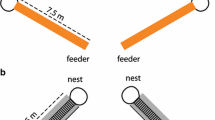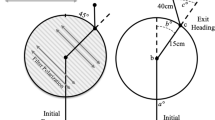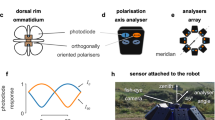Abstract
While integrating their foraging and homing paths, desert ants, Cataglyphis fortis, depend on external compass cues. Whereas recent research in bees and ants has focused nearly exclusively on the polarization compass, two other compass systems—the sun compass and the wind (anemo) compass—as well as the mutual interactions of all these compass systems have received little attention. In this study, we show that of the two visual compass systems, it is only the polarization compass that invariably outcompetes the wind compass, while the sun compass does so only under certain conditions. If the ants are experimentally deprived of their polarization compass system, but have access simultaneously to both their sun compass and their wind compass, they steer intermediate courses. The intermediate courses shift the more towards the wind compass course, the higher the elevation of the sun is in the sky.


Similar content being viewed by others
References
Batschelet E (1981) Circular statistics in biology. Academic, London
Benhamou S, Sauve JP, Bovet P (1990) Spatial memory in large scale movements: efficiency and limitation of the egocentric coding process. J Theor Biol 145:1–12
Brines ML, Gould JL (1982) Skylight polarization patterns and animal orientation. J Exp Biol 96:69–91
Duelli P, Wehner R (1973) The spectral sensitivity of polarized light orientation in Cataglyphis bicolor (Formicidae, Hymenoptera). J Comp Physiol 86:37–53
Edrich W, Neumeyer C, Helversen O (1979) “Anti-sun orientation” of bees with regard to a field of ultraviolet light. J Comp Physiol 134:151–157
Etienne A (2003) How does path integration interact with olfaction, vision, and the representation of space? In: Jeffery KJ (ed) The neurobiology of spatial behavior. Oxford University Press, Oxford, pp 48–66
Fent K (1985) Himmelsorientierung bei der Wüstenameise Cataglyphis bicolor. Bedeutung von Komplexaugen und Ocellen. Ph.D. Thesis, University of Zürich
Fent K, Wehner R (1985) Ocelli: a celestial compass in the desert ant Cataglyphis. Science 228:192–194
Fraenkel GS, Gunn DL (1961) The orientation of animals: kineses, taxes and compass reactions. Dover, New York
Heusser D, Wehner R (2002) The visual centring response in desert ants, Cataglyphis fortis. J Exp Biol 205:585–590
Kühn A (1919) Die Orientierung der Tiere im Raum. Jena: G. Fischer
Labhart T, Meyer EP (1999) Detectors for polarized skylight in insects: a survey of ommatidial specializations in the dorsal rim area of the compound eye. Microsc Res Tech 47:368–379
Lanfranconi B (1982) Kompassorientierung nach dem rotierenden Himmelsmuster bei der Wüstenameise Cataglyphys bicolor. Ph.D. Thesis, University of Zürich
Linsenmair KE (1969) Anemotaktische Orientierung bei Tenebrioniden und Mistkäfern (Insecta, Coleoptera). Z Vgl Physiol 64:154–211
Linsenmair KE (1970) Die Interaktion der paarigen antennalen Sinnesorgane bei der Windorientierung laufender Mist- und Schwarzkäfer (Insecta, Coleoptera). Z Vgl Physiol 70:247–277
Mittelstaedt H (1983) The role of multimodal convergence in homing by path integration. Fortschr Zool 28:197–212
Rossel S (1989) Polarization sensitivity in compound eyes. In: Stavenga DG, Hardie RC (eds) Facets of vision. Springer, Berlin Heidelberg New York pp 298–316
Rossel S, Wehner R (1984) Celestial orientation in bees: the use of spectral cues. J Comp Physiol [A] 155:605–613
Santschi F (1911) Observations et remarques critiques sur le mécanisme de l’orientation chez les fourmis. Rev Suisse Zool 19:303–338
Stephens MA (1962) Exact and approximate tests for directions. I, II. Biometrika 49:463–477, 547–552
Wehner R (1982) Himmelsnavigation bei Insekten. Neurophysiologie und Verhalten. Orell Füssli, Zürich
Wehner R (1992) Antrhropods. In: Papi F (ed) Animal homing. Chapman & Hall, London, pp 45–144
Wehner R (1994) The polarization-vision project: championing organismic biology. Fortschr Zool 39:103–105
Wehner R, Duelli P (1971) The spatial orientation of desert ants, Cataglyphis bicolor, before sunrise and after sunset. Experientia 27:1364–1366
Wehner R, Labhart T (2006) Polarisation vision. In: Warrant EJ, Nilsson D-E (eds) Invertebrate vision. Cambridge University Press, Cambridge, pp 291–348
Wehner R, Müller M (2006) The significance of direct sunlight and polarized skylight in the ant’s celestial system of navigation. Proc Natl Acad Sci USA 103:12575–12579
Wehner R, Rossel S (1985) The bee’s celestial compass—a case study in behavioral neurobiology. Fortschr Zool 31:11–53
Wehner R, Srinivasan MV (2003) Path integration in insects. In: Jeffery KJ (ed) The neurobiology of spatial behaviour. Oxford University Press, Oxford, pp 9–30
Wolf H, Wehner R (2000) Pinpointing food sources: olfactory and anemotactic orientation in desert ants, Cataglyphis fortis. J Exp Biol 203:857–868
Wolf H, Wehner R (2005) Desert ants compensate for navigation uncertainty. J Exp Biol 208:4223–4230
Zollikofer CPE, Wehner R, Fukushi T (1995) Optical scaling in conspecific Cataglyphis ants. J Exp Biol 198:1637–1646
Acknowledgements
We thank all who have helped us in performing this study: Magdalena Götz and Gisela Müller for help in the field experiments, Stefan Sommes for his expertise in statistics, and Ursula Menzi for expert help in designing the figures. Financial support came from the Swiss National Science Foundation (to R.W.).
Author information
Authors and Affiliations
Corresponding author
Rights and permissions
About this article
Cite this article
Müller, M., Wehner, R. Wind and sky as compass cues in desert ant navigation. Naturwissenschaften 94, 589–594 (2007). https://doi.org/10.1007/s00114-007-0232-4
Received:
Revised:
Accepted:
Published:
Issue Date:
DOI: https://doi.org/10.1007/s00114-007-0232-4




